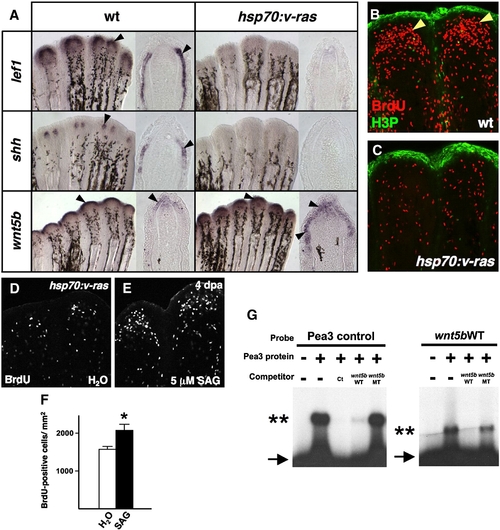Fig. 7
|
Transgenic Fgf/Ras distalizes the regeneration epidermis, blocking blastemal proliferation. (A) Whole-mount ISH and representative sections of 4 dpa regenerates from wildtype and hsp70:v-ras animals, collected 5 h after a heat-shock. lef1 and shh expression are abolished during Ras activation, while wnt5b expression is expanded. (B, C) BrdU incorporation (red) and phosphorylated Histone 3 (H3P; green) assessment in wildtype (B) and hsp70:v-ras (C) 4 dpa fin regenerates 5 h after a single heat-shock. Blastemal proliferation (arrowheads) is markedly reduced by brief Ras activation in transgenic regenerates, as compared to wildtype regenerates. (D, E) Images of BrdU incorporation in 4 dpa fin regenerates from heat-shocked hsp70:v-ras zebrafish treated with SAG or vehicle. SAG partially rescued blastemal proliferation. (F) Quantification of BrdU-positive cells in SAG- and vehicle-treated hsp70:v-ras animals (n = 12; mean ± SEM; Student′s t-test, *P < 0.05). (G) Electrophoretic mobility shift assays of binding by zebrafish Pea3 protein to a binding element upstream of the zebrafish wnt5b transcription start site. (Left) Excess addition of non-labeled wnt5b oligo (wnt5bWT) effectively competes for binding between in vitro translated Pea3 DNA-binding domain and a radiolabeled canonical binding site (Pea3 control; Ct). Arrow indicates unbound radiolabeled oligo; double asterisks marks shifted complex. A wnt5b oligo containing two nucleotide changes (wnt5bMT) fails to compete. (Right) Radiolabeled wnt5bWT mobility is shifted by the zebrafish Pea3 DNA-binding domain, an interaction competed by excess unlabeled wnt5bWT oligo. |
Reprinted from Developmental Biology, 331(2), Lee, Y., Hami, D., De Val, S., Kagermeier-Schenk, B., Wills, A.A., Black, B.L., Weidinger, G., and Poss, K.D., Maintenance of blastemal proliferation by functionally diverse epidermis in regenerating zebrafish fins, 270-280, Copyright (2009) with permission from Elsevier. Full text @ Dev. Biol.

